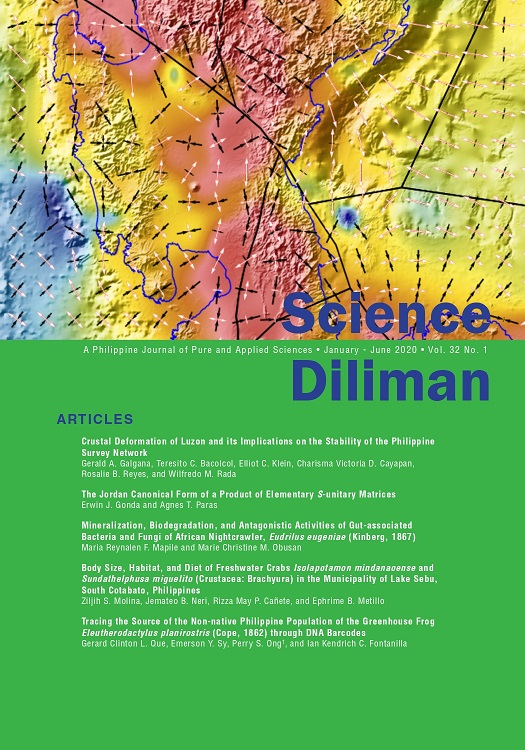Tracing the Source of the Non-Native Philippine Population of the Greenhouse Frog <em>Eleutherodactylus planirostris</em> (Cope, 1862) through DNA Barcodes
Abstract
Eleutherodactylus planirostris (Cope 1862), commonly called the Greenhouse Frog, is an insectivorous, direct-developing frog native to the Caribbean. It has been widely introduced outside of its native range and has been known to reach population densities of bout 12,500 frogs per hectare, posing a potential ecological threat in areas of its introduction, especially to local insect populations. Recently, the species has been detected on several islands throughout the Philippines. Samples for this study were obtained from two locations in Quezon City (Luzon Island) and one location in Bacolod City (Negros Island). DNA barcoding using three genes (Cytochrome b, 16S rDNA, and Cytochrome Oxidase subunit 1) was performed with the objective of identifying the source population of Philippine E. planirostris. Our results indicate that E. planirostris samples in the Philippines are identical genetically to populations in Hawai’i and Florida, USA and are closely related to an individual from Matanzas, Cuba. A haplotype network built using the Fitch algorithm also supports the Cuban origin of the Philippine samples. Moreover, the Philippine specimens have nearly identical sequences for all three genes, which may have implications on its success as an introduced species.
Published
2020-09-17
How to Cite
QUE, Gerard Clinton L. et al.
Tracing the Source of the Non-Native Philippine Population of the Greenhouse Frog Eleutherodactylus planirostris (Cope, 1862) through DNA Barcodes.
Science Diliman: A Journal of Pure and Applied Sciences, [S.l.], v. 32, n. 1, sep. 2020.
ISSN 2012-0818.
Available at: <https://journals.upd.edu.ph/index.php/sciencediliman/article/view/7217>. Date accessed: 25 sep. 2025.
Issue
Section
Articles
Keywords
DNA Barcoding, Eleutherodactylus planirostris, cytb, 16S, cox1, Cuba
Submission of a manuscript implies: that the work described has not been published before (except in the form of an abstract or as part of a published lecture, review, or thesis); that it is not under consideration for publication elsewhere; that its publication has been approved by all co-authors, if any, as well as by the responsible authorities at the institute where the work has been carried out; that, if and when the manuscript is accepted for publication, the authors agree to the automatic transfer of the copyright to the publisher; that the manuscript will not be published elsewhere in any language without the consent of the copyright holders; that written permission of the copyright holder is obtained by the authors for material used from other copyrighted sources; and that any costs associated with obtaining this permission are the authors’ responsibility.



